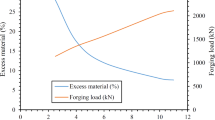Abstract
Design optimization of layered plate bonding process is conducted by considering uncertainties in a manufacturing process, to reduce the crack failure arising due to the difference of thermal expansion coefficients of the adherents. Robust optimization is performed to minimize the mean and variance of the residual stress, which is the major cause of the failure, while constraining the distortion and the instantaneous maximum stress to the allowable limits. In this optimization, the dimension reduction (DR) method is employed to quantify the uncertainty of the responses in the bonding process. It is expected that the DR method benefits the optimization from the perspectives of efficiency, accuracy, and simplicity. Response surface method (RSM) combined with sequential approximate optimization (SAO) technique is employed as an optimization tool. The obtained robust optimal solution is verified by the Monte Carlo simulation.
Similar content being viewed by others
References
Basaran C, Zhao Y (2001) Mesh sensitivity and FEA for multi-layered electronic packaging. Trans ASME, J Electron Packag 123(3):218–224
Chen D, Cheng S, Gerhardt TD (1982) Thermal stresses in laminated beams. J Thermal Stresses 5:67–84
Chen W, Allen JK, Tsui KL, Mistree F (1996) Procedure for robust design: minimizing variations caused by noise factors and control factors. ASME J Mech Des 118(4):478–485
Glaser JC (1989) Thermal stresses in compliantly-joined materials. ASME Winter Annual Meeting. 89-WA/EEP-14. San Francisco, CA
Haldar A, Mahadevan S (1999) Probability, reliability, and statistical methods in engineering design. Wiley
Hasofer AM, Lind NC (1974) Exact and invariant second-moment code format. ASCE, J Eng Mech 100:111–121
Jiang ZQ, Huang Y, Chandra A (1997) Thermal stresses in layered electronic assemblies. J Electron Pack 119:127–133
Jung DH, Lee BC (2002) Development of a Simple and Efficient Method for Robust Optimization. International Journal for Numerical Methods in Engineering 53:2201–2215
Kleiber M, Hien TD (1992) The Stochastic Finite Element Method. Wiley, New York
Lee WH, Kim HJ, Joo JW, Choi JH (2006a) Material parameters identification in the layered plates bonding process simulation using Moiré Interferometric measurement and optimization technique. The Fourth China–Japan–Korea Joint Symposium on Optimization of Structural and Mechanical Systems, Kunming, China, November
Lee I, Choi KK, Du L (2006b) Alternative Methods for Reliability-Based Robust Design Optimization Including Dimension Reduction Method. ASME DETC, Philadelphia, Pennsylvania, September 10–13
Lee SH, Kwak BM (2006) Response surface augmented moment method for efficient reliability analysis. Struct Saf 28:261–272
Lee TW, Kwak BM (1987-88) A reliability-based optimal design using advanced first order second moment method. Mech Struct Mach 15(4):523–542
Lee YB, Lee HJ, Kim MS, Choi DH (2005) Sequential approximate optimization based on a pure quadratic response surface method with noise filtering. Transactions of the KSME (A) 29(6):842–851
Lin CY, Huang WH, Jeng MC, Doong JL (1997) Study of an assembly tolerance allocation model based on Monte Carlo simulation. J Mater Process Technol 70:9–16
Park GJ, Lee TH, Lee KH, Hwang KH (2004) A review of robust design methodologies. Transactions of KSME(A) 28(9):1368–1383
Phadke MS (1989) Quality engineering using robust design. Prentice Hall, Englewood Cliffs, New Jersey
Rahman S, Xu H (2004) A univariate dimension-reduction method for multi-dimensional integration in stochastic mechanics. Probab Eng Mech 19:393–408
Shih CF, Asaro RJ (1988) Elasto-plastic analysis of cracks on bi-material interfaces: Part I—small scale yielding. ASME, J Appl Mech 55:299–316
Shih CF, Asaro RJ (1989) Elasto-plastic analysis of cracks on bi-material interfaces: Part II—structure of a small-scale yielding fields. ASME, J Appl Mech 56:763–779
Plotner M, Donat B, Benke A (1991) Deformation properties of indium-based solders at 294 and 77 K. Cryogenics 31(3):159–162
Suhir E (1989) Interfacial stresses in bimetal thermostats. ASME J Appl Mech 56:595–600
Suhir E, Weld JD (1998) Application of a “surrogate” layer for lower bending stress in a vulnerable material of a tri-material body. Microelectronics Reliability 38:1949–1954
Suhir E (2001) Predicted thermal stresses in a bimaterial assembly adhesively bonded at the ends. J Appl Physi 89(1):120–129
Tu J, Choi KK (1999) A new study on reliability based design optimization. J Mech Des, ASME 121(4):557–564
Varghese P, Braswell RN, Wang B, Zhang C (1996) Statistical tolerance analysis using FRPDF and numerical convolution. CAD 28(9):723–732
Vining G, Myers R (1990) Combining Taguchi and response surface philosophies—a dual response approach. J Qual Technol 22:38–45
Youn BD, Choi KK, Du L (2004) Adaptive probability analysis using an enhanced hybrid mean value (HMV+) method. Journal of Structural and Multidisciplinary Optimization. 28(4):319–333
Youn BD, Choi KK, Du L (2005) Performance moment integration (PMI) method for quality assessment in reliability-based robust design optimization. Mechanics Based Design of Structures and Machines. 33:185–213
Zhao YG, Ono T (2001) Moment methods for structural reliability. Struct Saf. 23:47–75
Author information
Authors and Affiliations
Corresponding author
Rights and permissions
About this article
Cite this article
Choi, J.H., Lee, W.H., Park, J.J. et al. A study on robust design optimization of layered plate bonding process considering uncertainties. Struct Multidisc Optim 35, 531–540 (2008). https://doi.org/10.1007/s00158-007-0153-z
Received:
Revised:
Accepted:
Published:
Issue Date:
DOI: https://doi.org/10.1007/s00158-007-0153-z




